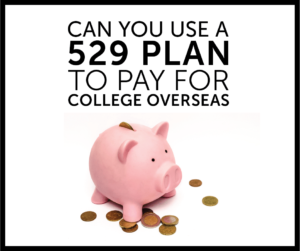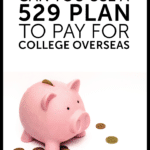
It is possible to use a 529 plan to study abroad, or to pay for educational expenses at international schools and universities.
Traveling abroad is exciting, yet few college students get to have this experience, simply because they didn’t know how to make it an affordable and accessible option. While most students want to go abroad and learn while being immersed in another culture, the staggering cost is a huge obstacle to spending time studying abroad and gaining life experience.
Don’t let the cost discourage you- there may be a tax-free way to study abroad and have the adventures and experiences you will remember for life, so keep reading!
It's possible to use a 529 plan to pay for college (or even potentially elementary K-12 education) abroad. Here's what to know.
What Is A 529 Plan?
529 plans, legally known as “qualified tuition plans,” are sponsored by states, state agencies, or educational institutions and are authorized by Section 529 of the Internal Revenue Code.
A 529 plan is a tax-advantaged savings plan designed to encourage and reward people who save for future college expenses. The 529 plan college-savings accounts programs are also regulated by the Internal Revenue Service. Because 529 plans are specifically designated for higher education, they also provide tax benefits.
Distributions taken from a 529 plan are allocated between principal and earnings on a pro-rata basis, which means that every withdrawal includes an earnings portion. As a result, there are enforced limitations on 529 plan qualified expenses.
The SEC provides that there are two types of 529 plans: pre-paid tuition plans and college savings plans. All fifty states and the District of Columbia sponsor at least one type of 529 plan. In addition, a group of private colleges and universities also sponsor a pre-paid tuition plan.
Because 529 Plans are state-sponsored college savings accounts, the rules determining plan use and fund withdrawal capabilities can vary, so it is of the utmost importance to speak to your 529 plan provider for information on plan withdrawal terms and conditions.
Also, interest rates (the main reason for a 529 plan) significantly vary by fund, so research your options before selecting your funds. You should also budget a monthly contribution to fund your 529 plan.
Benefits Of A 529 Plan
There are many benefits to participating in your state’s 529 plan. However, with those benefits come restrictions, since qualified withdrawals are strictly limited to specified higher-education expenditures.
When you invest in a 529 account, the savings grow significantly faster than your average savings account. This is the main benefit of a 529 that makes the cost of studying abroad much more manageable than a traditional savings account.
How A 529 Can Be Used To Help Students Study Abroad
Most (but not all) study-abroad program expenses can be funded through withdrawals from a 529 account. 529 distributions are tax-free if they are used to pay for qualified higher education expenses at a college or university that is eligible for Title IV higher federal education aid.
These higher education institutions will have a federal school code that can be listed on the Free Application for Federal Student Aid (FAFSA). There are more than 100 foreign colleges that are eligible for federal student aid.
You can use 529 plan funds to pay for study abroad expenses if the study program at the foreign institution is eligible for credit at the student's US home institution, and if the foreign institution is eligible for Title IV federal student aid, which can be determined by looking for the federal school code.
In simple terms, your school has to give credit for the study abroad program, and the foreign college where you will be studying abroad must be eligible for financial aid.
For more details about the types of study abroad programs, compare the reviews sorted by country, program and duration to see how they can benefit your education. By creating a budget and savings plan for your international studies, you will be able to quickly fund your 529 plan and meet your goal.
Learn how to start saving with a 529 plan and watch your account grow.
What Expenses Can a 529 Be Used To Pay When Studying Abroad?
Qualified Expenses for enrollment or attendance at the institution normally fall into one of these three main categories:
1. Tuition, Fees, Books, Supplies, and Equipment
The majority of study-abroad expenses consist of tuition, fees and approved room-and-board expenses, which are eligible to be funded through withdrawals from a 529 plan college-savings account. Required textbooks and supplies (which can get expensive really fast!) are also covered.
2. Room and Board
Room and board includes the costs of rent (whether living on or off-campus), and food. The expenses must be less than or equal to the room and board allowance from the college’s cost of attendance figures (or the actual amount charged by the school if the student is living on campus) in order to be considered as qualified expenses. Also, the student must have at least half-time enrollment status to qualify, regardless of whether or not they live on campus.
The IRS requires that for room-and-board expenses to qualify for 529 withdrawals, they must be a direct educational expense. If you take a vacation while studying abroad and stay at another location, that room and board expense will not qualify.
3. Computers, Peripheral Equipment, Computer Software, and Internet Access Charges
Previously, the school had to specifically require computers, peripheral equipment, software and Internet access in order to consider these as qualified expenses. With recent changes observing the necessity for technological equipment in education, they are all considered qualified expenses.
What Can A 529 Not Be Used To Pay?
While the definition of a ‘qualified expense’ appears to be all-inclusive, there are many expenses that are not covered as a qualified expense. In fact, many people mistakenly claim some of these expenses only to find that they are not qualified expenses, which can result in unexpected tax penalties.
Travel: Costs to commute to and from school do not qualify. Surprisingly, gas, airfare, and bus fare are all excluded from transportation costs. A word of caution- if you go on weekend trips or spring-break trips not related to educational activities away from your study abroad campus, those expenses will not be covered.
Sports and Activity Fees: Expenses for extracurricular activities such as sports and recreational activities cannot be reimbursed from a 529 account. Interestingly enough, even if the beneficiary has a sports scholarship, the expenses related to sports activities still cannot be paid from a 529 account.
Student loans: A 529 account cannot be use to pay back student loans, generally. However, you can use a one-time $10,000 withdraw to pay student loans. Some states DON'T allow this.
Certain Electronics: While computers and software are now allowed as a qualified expense, other electronics traditionally used for entertainment, such as theater equipment are projectors are not qualified expenses (unless the items are specifically required by the school for enrollment or attendance).
Insurance: Medical expenses and health insurance premium do not qualify. Neither are international healthcare costs or, not unsurprisingly, foreign transaction fees. Such ineligible expenses need to be figured into the overall cost of the trip.
Important Information about the American Opportunity Tax Credit (AOTC) or Lifetime Learning Credit – Expenses used to qualify for the AOTC or Lifetime Learning Credit must be excluded from qualified expenses.
When Penalties Apply
Non-qualified withdrawals are subject to income tax as well as a 10 percent penalty on the earnings portion of the withdrawal, which is why it is important to be sure you attend an IRS-eligible educational institution, the expenses qualify, and you are enrolled at minimum as a half time student. There are rare exceptions to withdrawing without penalty, such as veteran’s assistance, attending a U.S. military academy, disability, or death.
First, be sure that the expenses are qualified expenses from an eligible educational institution. Next, make sure that a qualifying person incurred the expenses when the expenses were incurred.
The qualified expenses need to be incurred by the student in connection to attendance or enrollment at a university. While the parent may pay the actual bill, the debt itself must belong to the student.
Withdrawals taken from a 529 plan must also be taken in the same calendar year that the qualified expenses are paid.
If someone else pays your expenses and you reimburse them, you are still able to make a withdrawal from your 529 plan. The withdrawal will generate a 1099 to you as the account owner, and you will need to trace the withdrawal back to the expense.
Learn more about the 529 plan penalty (and how to avoid it) here.
You Can Use Your 529 To Study Abroad If You Follow The Rules
While most people dream about studying abroad and experiencing life outside of the country, the high price tag associated with tuition and room and board fees prevents most students from applying to study abroad. Fortunately, the 529 plan gives you hope by allowing students save money on qualified expenses, and qualified expenses are the majority of the cost of studying abroad. Do your research to get a clear understanding of how much it will cost so you can work towards your goal.
Key Points To Remember
- The 529 distribution must be used to pay for qualified higher education expenses.
- The educational institution must be eligible for at the student’s US home institution.
- The foreign college must be Title IV federal student aid.
- The student must at least be enrolled as a half time student.
- When used properly, the 529 plan alleviates the burden of this expensive (yet worthwhile) experience!
- Tell us your plans for how you will use your 529 plan to study abroad in the comments below!
When used properly, the 529 plan alleviates the burden of this expensive (yet worthwhile) experience!
Tell us your plans for how you will use your 529 plan to study abroad in the comments below!

Robert Farrington is America’s Millennial Money Expert® and America’s Student Loan Debt Expert™, and the founder of The College Investor, a personal finance site dedicated to helping millennials escape student loan debt to start investing and building wealth for the future. You can learn more about him on the About Page or on his personal site RobertFarrington.com.
He regularly writes about investing, student loan debt, and general personal finance topics geared toward anyone wanting to earn more, get out of debt, and start building wealth for the future.
He has been quoted in major publications, including the New York Times, Wall Street Journal, Washington Post, ABC, NBC, Today, and more. He is also a regular contributor to Forbes.
Editor: Clint Proctor Reviewed by: Mark Kantrowitz
